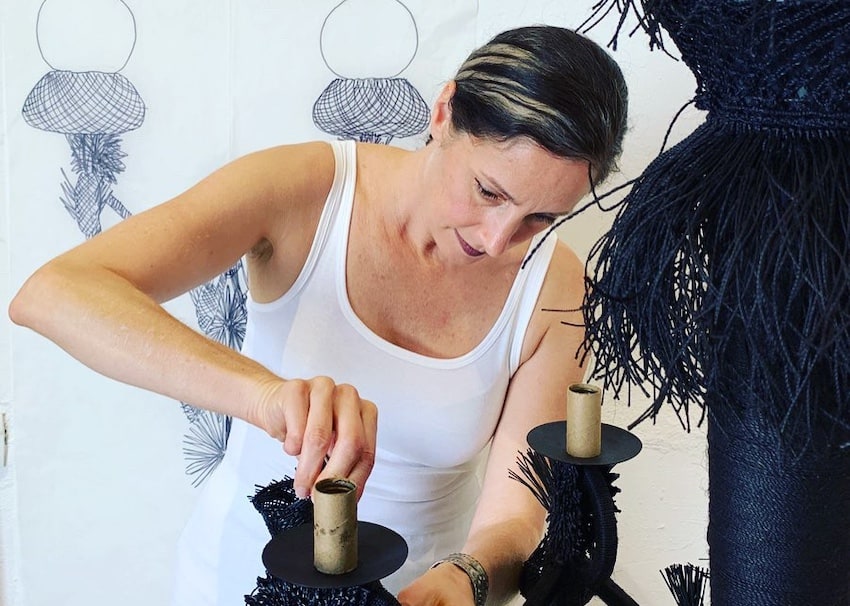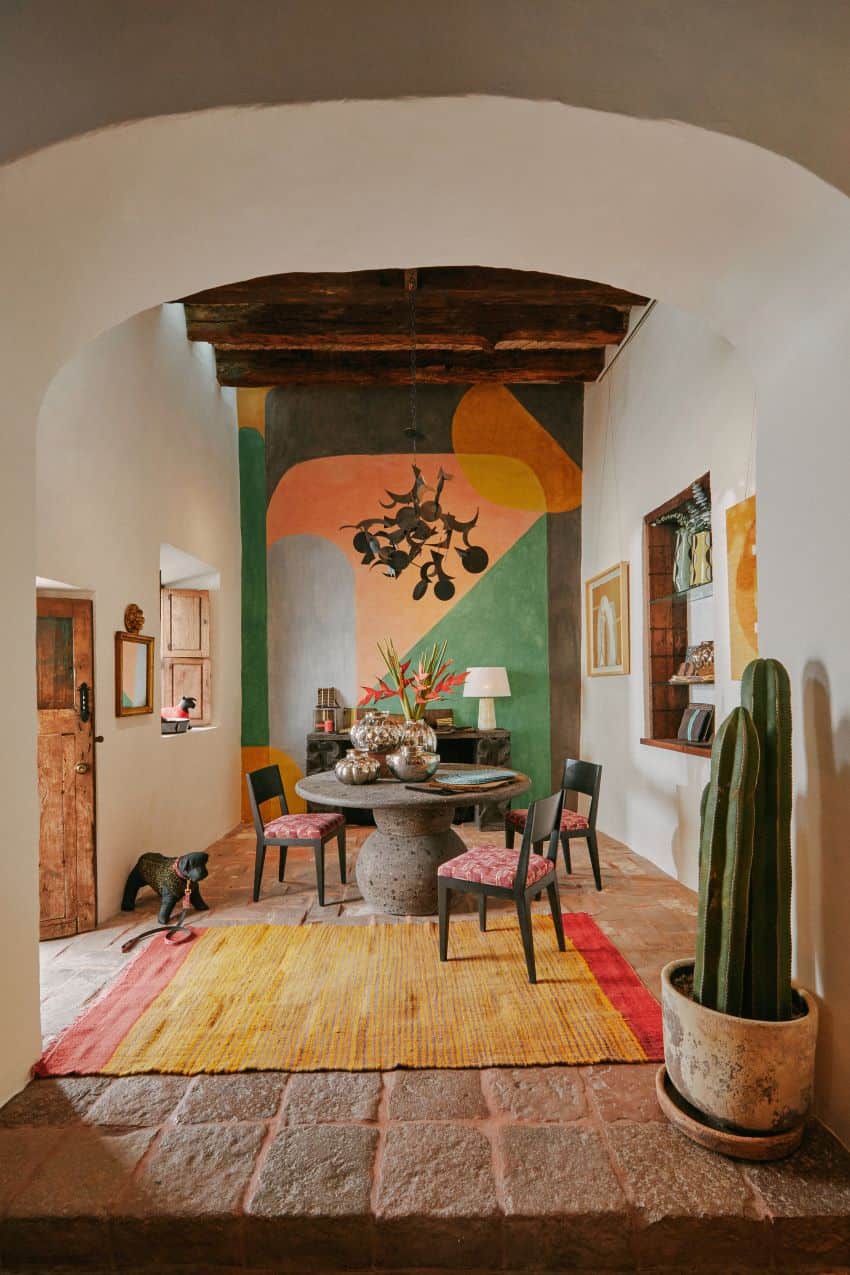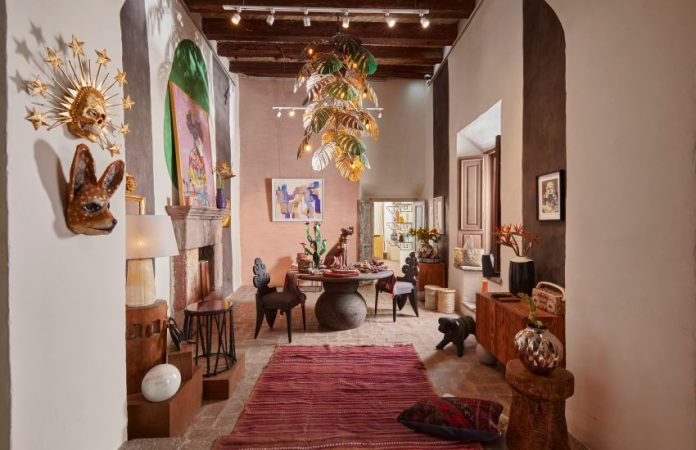If you want to explore the best of the Mexican interior design scene, you need to know about San Miguel de Allende-based Laura Kirar. While she has Italian roots, Kirar has skillfully interwoven the essence of Mexican culture with contemporary sophistication through her one-of-a-kind creations.
As a prominent figure in the avant-garde interior design scene worldwide, what sets Kirar’s work apart, is the seamless blend of art and interior design. She considers herself an artist who envisions and transforms interior design into sculptural forms. Her style is renowned for its elegance, and she is passionate about crafting spaces that create experiences and moments. Kirar believes that her designs awaken something within people, prompting them to create their own memories.

She first made her name by creating conceptual furniture, such as chairs that were intentionally uncomfortable and not meant for sitting, and fragile embroidered threads that disintegrate over time.
More recently, her work has graced major brands, with her freestanding bathtub and mirror for Kallista and Baker Furniture’s lighting projects becoming highly sought-after pieces by collectors across the world.
So who is this contemporary interior designer and artist? How did she come to fall in love with Mexican art and culture? In an exclusive interview with Mexico News Daily, Kirar discusses her personal sources of inspiration and her deep connection to Mexican culture. She also shares her knowledge of the Mexican design scene and much more.
Who is Laura Kirar as an influential creative in contemporary interior design?
I see myself as an artist, designer, and project director. I am very interested in materials, circumstances, and environments and especially in collaborations: in making projects with other creative minds, artisans, craftsmen, filmmakers, designers, and producers.

Also, I’m interested in the idea of collaboration between myself as an artist and the people who experience my creations, because the work I make is not necessarily about me. It’s about creating a context where people can experience and create their own memories. It’s like creating moments of clarity, of impact for people who are in my interiors, who use my furniture, and who experience the installations. I want the person who’s interacting with these spaces to be brought into the present, but also to be transported out of the reality of where they are.
What were your creative motivations when you started your career and how do they change as a contemporary interior designer?
When I started studying industrial design, I didn’t really know what I was doing. I went to the School of the Art Institute of Chicago and they didn’t have an industrial design department, so I was studying sculpture, and making metal sculptures, and I also had a very strong interest in architecture.
The first thing I did was create installations and spaces that would attract and stimulate the senses. But what I found myself doing was creating sculptures for these spaces: I was thinking a lot about domesticity and how certain objects in a home or a space communicate a use, and I wanted to challenge that.
I also saw the objects within a home or a space, often. I don’t know why, but somehow they also had a gender like a female or a male, and I also wanted to challenge domestic interpretation and domestic roles, so I started making conceptual furniture: like chairs that weren’t comfortable at all and weren’t meant to be sat on, or things that had woven surfaces that I would weave myself but that would intentionally disintegrate over a shorter period.
So there was a level of impermanence in the things I was making. It was kind of through a very conceptual lens that I found my way into making more commercial work and creating functional furniture pieces and designs that would eventually lead me down a very long path of creating collections for larger brands like Holly Hunt, Ralph Lauren, eventually Kohler Company, Baker Furniture, Arteriors Home… So it was a very organic path that led me into making furniture and industrial design.
What are your creative motivations right now as an influential creative in contemporary interior design?
It depends on the project. I’ve always had projects for corporate brands, designing into their brand, designing into their image, but of course, putting my stamp on the collection or the piece. Right now it’s a pivotal point for me because I’m coming full circle to where I was maybe 30 years ago and I’m doing more conceptual pieces again, sculpture and art. I think what I’m trying to do and communicate is about my experience of the world, but I also feel like it’s something in the ether, it’s something in the air that resonates with a lot of people, not just me. I’m very concerned about the environment, pollution, landscape, language and culture, and how all these things intersect and affect people’s lives.

So for the last four years, I’ve been working in ceramics and I created this piece called ‘Forum Glyph’ and the whole purpose is that it’s a big table made out of a material that’s delicate and kind of challenging to create.
And the idea is that this Forum, this table for eight people, immediately puts their minds and their bodies in a certain context of respect and caution. It’s a forum for communication and exchange, a round table, so there’s no head, everybody’s there with an equal distribution of power. So these are things that I think about when I imagine a piece. Maybe if you don’t know the story behind the idea, maybe those things are communicated in a very subliminal way or maybe the pieces are just aesthetic; not everybody knows about the conceptual aspect of the work and I think that’s okay.
You describe your interior designs as a sculpture, could you tell us more about it and how this is special in the contemporary interior design scene?
The way I think about spaces is very much about how the body is going to move through them. So I walk into a space that I’m doing for a new client and usually within 30 seconds know what needs to happen in it; it’s because I can see myself and the client or anybody walking through the space, living it, experiencing it. Then the way I look at it, I think it’s like creating a sculpture or a painting. I call it a sculpture because it’s three-dimensional and of course, it’s an interior. But for me, a great painting is something that has a certain level of balance or intentional imbalance: the eye travels around this two-dimensional plane and then there’s something about it that gives you a sense of the interior architecture of a space. I think about how I would create a sculpture with certain parts being heavier, and some parts being lighter and making the body feel a certain way within that space. You can do that with colors, materials, textures, and objects, all of those things are a palette to put within the volume of the architecture.
What is your creative relationship with Mexico as an artist and interior designer?
Creatively, my relationship with Mexico is very complex. It has a lot to do with being challenged by a very rich history and a deep culture that on many levels is so different from the one I grew up with. And then on other levels, there’s a lot that resonates for me because of my Italian family background. There’s some similarity in the culture, especially in terms of the family, which is very similar to the way I grew up. Then the proportions, colors, the painterly quality, and all the incredible craftsmanship and history of the indigenous cultures for me was something I started a love affair with 20 years ago, and I still haven’t gotten over it.
It’s still an inspiration to me, a mystery, and it’s influenced my work. The collaborative relationships that I’ve had with the best artisans, the most talented craftsmen, and certainly in materials: are so many years doing a deep dive on techniques and materials here.
What’s next in your career as part of the interior design scene and artist?
I think I’ve come full circle and I’m starting to make more art: I just showed a piece at Miami during Art Basel and I’m going to show at Zona Maco. At the same time, I’m still working with clients, doing interiors, designing hotels, homes and my collection with Kallista. I have new collections coming out, and then there’s this other part of me that’s growing, and expanding: I feel like that’s the core of who I am, expanding myself as an artist.
What would you say about San Miguel de Allende, where you have your studio as part of the Mexican design and art scene?
I would say that I feel very fortunate to be living my life as an artist, splitting my time between San Miguel de Allende, Mérida, and also Mexico City: all of these places are so incredibly different and give just a little bit of the diverse cultures of Mexico.

Different places have influenced me a lot, and San Miguel was kind of an instrumental place for me to show some of the work that I have been doing with artisans in Mexico and also a platform to express myself and my interpretation of what a contemporary San Miguel looks like that is still rooted in the tradition of Guanajuato. That is Mesón Hidalgo, which has been widely published and was on the cover of Condé Nast Traveler for September: that was a great honor for us because that project celebrated my collaborations with young artists and artisans from Mexico. It’s like a great fusion of the tradition of Mexico with what’s happening now and what’s going to happen in the future in Mexican design. So it’s been a great experience to be in San Miguel.
What would you say about the Mexican design scene as an influential contemporary interior designer?
It’s kind of like a love affair with Mexico, I’m so delighted. It’s hard for me to imagine anything else, but I feel like Mexico is the center of the universe right now and Mexican design is so incredibly strong and influential. I think Mexico is going through a renaissance and the design and art that’s coming out of it right now is kind of unparalleled.
Ana Paula de la Torre is a Mexican journalist and collaborator of various media such as Milenio, Animal Político, Vice, Newsweek en Español, Televisa and Mexico News Daily.
